University Management: Internal and External Factors Impact Analysis
VerifiedAdded on 2020/02/23
|8
|2055
|117
Report
AI Summary
This report, focusing on the principles of management, examines the impact of both internal and external factors on a business's operating environment. The internal factors discussed include leadership styles, employee strength, inter-departmental procedures, organizational and operational factors, strategic risks, innovation, and financial structure. The report emphasizes that these factors are within the organization's control. External factors, which are beyond the organization's direct influence, are categorized into general and task environments. The general environment encompasses economic, technological, socio-cultural, political-legal, and international elements. The task environment includes competitors, customers, suppliers, regulators, and strategic partners. The report highlights the use of SWOT and PESTLE analyses for understanding and applying internal and external factors, respectively. The conclusion stresses the importance of managerial awareness of these environmental elements for organizational success in a dynamic business landscape.
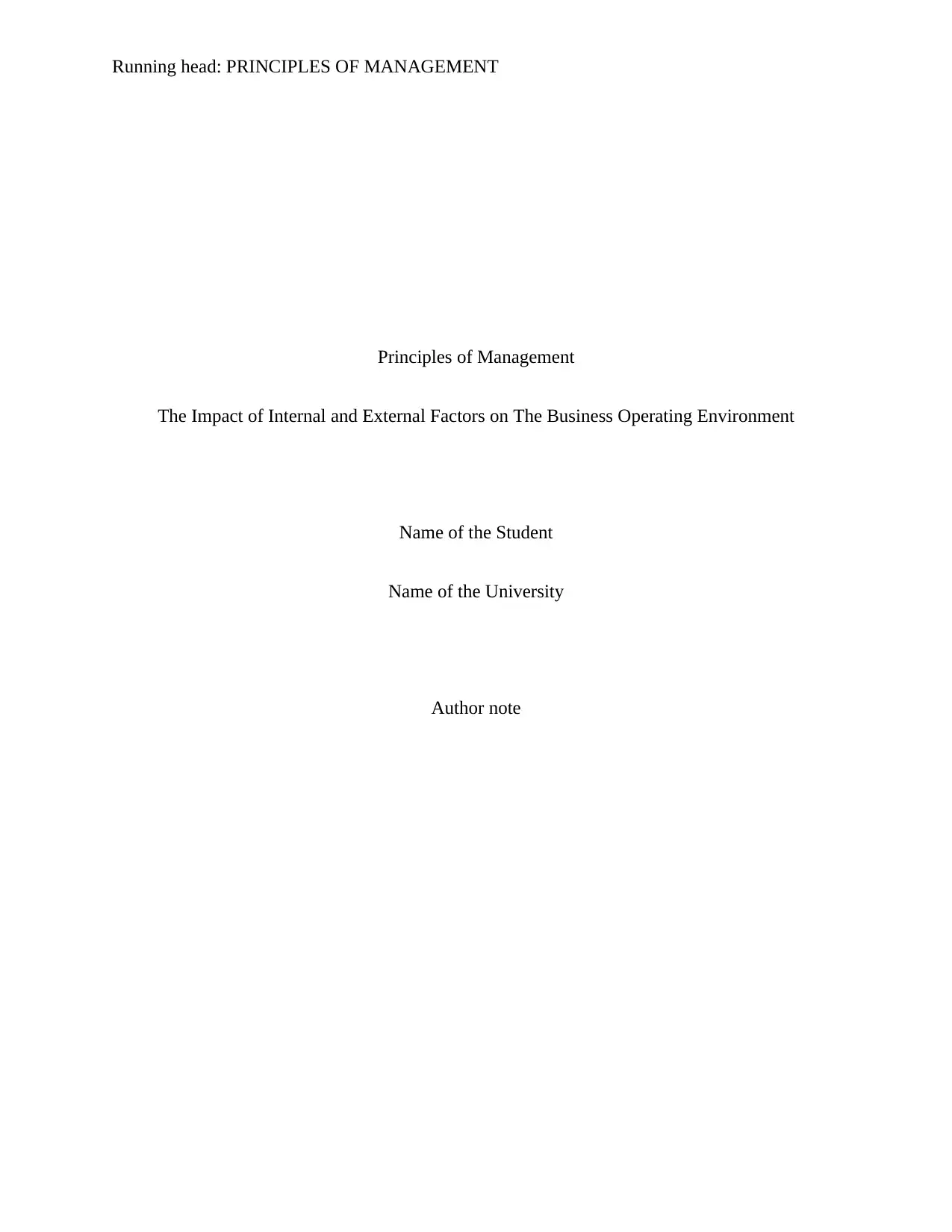
Running head: PRINCIPLES OF MANAGEMENT
Principles of Management
The Impact of Internal and External Factors on The Business Operating Environment
Name of the Student
Name of the University
Author note
Principles of Management
The Impact of Internal and External Factors on The Business Operating Environment
Name of the Student
Name of the University
Author note
Paraphrase This Document
Need a fresh take? Get an instant paraphrase of this document with our AI Paraphraser
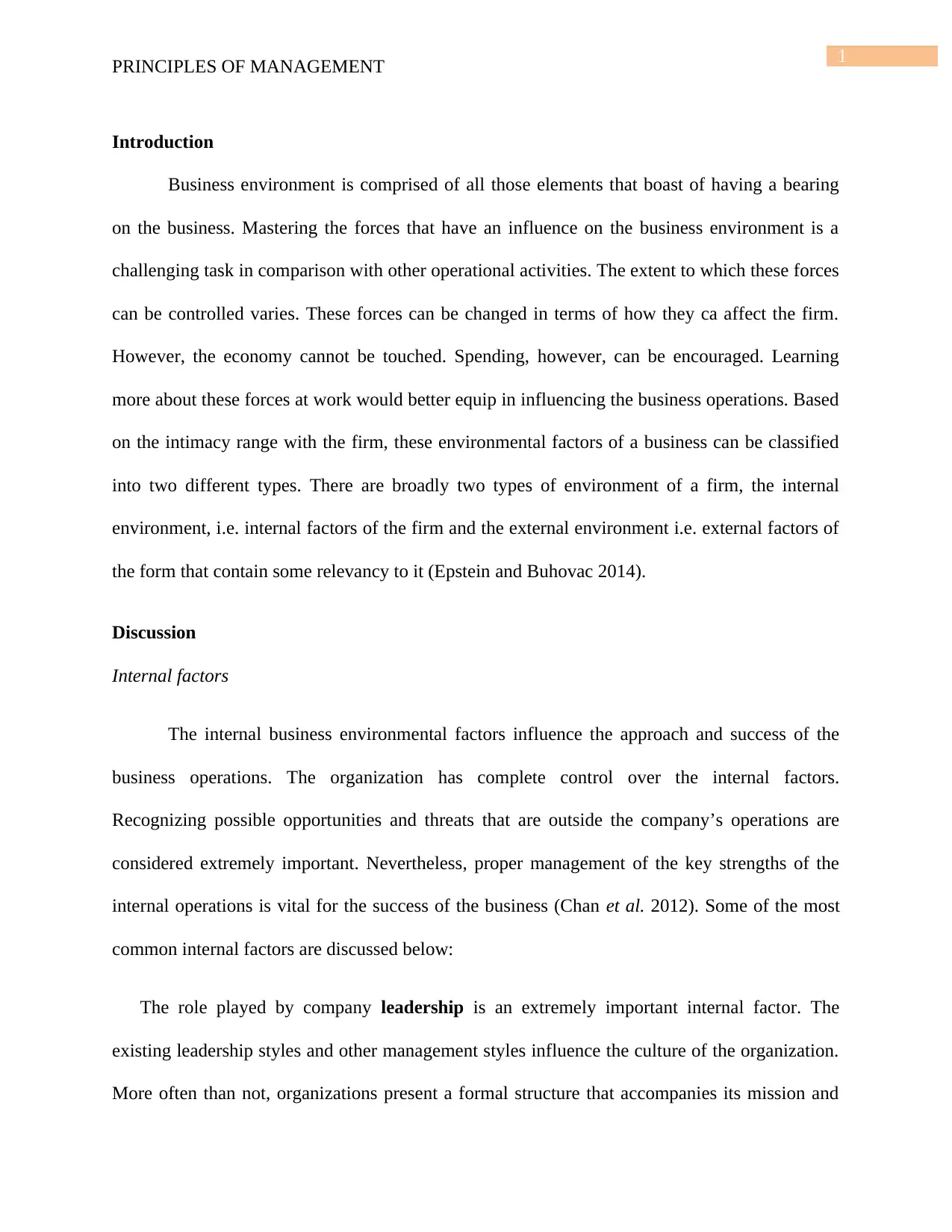
1
PRINCIPLES OF MANAGEMENT
Introduction
Business environment is comprised of all those elements that boast of having a bearing
on the business. Mastering the forces that have an influence on the business environment is a
challenging task in comparison with other operational activities. The extent to which these forces
can be controlled varies. These forces can be changed in terms of how they ca affect the firm.
However, the economy cannot be touched. Spending, however, can be encouraged. Learning
more about these forces at work would better equip in influencing the business operations. Based
on the intimacy range with the firm, these environmental factors of a business can be classified
into two different types. There are broadly two types of environment of a firm, the internal
environment, i.e. internal factors of the firm and the external environment i.e. external factors of
the form that contain some relevancy to it (Epstein and Buhovac 2014).
Discussion
Internal factors
The internal business environmental factors influence the approach and success of the
business operations. The organization has complete control over the internal factors.
Recognizing possible opportunities and threats that are outside the company’s operations are
considered extremely important. Nevertheless, proper management of the key strengths of the
internal operations is vital for the success of the business (Chan et al. 2012). Some of the most
common internal factors are discussed below:
The role played by company leadership is an extremely important internal factor. The
existing leadership styles and other management styles influence the culture of the organization.
More often than not, organizations present a formal structure that accompanies its mission and
PRINCIPLES OF MANAGEMENT
Introduction
Business environment is comprised of all those elements that boast of having a bearing
on the business. Mastering the forces that have an influence on the business environment is a
challenging task in comparison with other operational activities. The extent to which these forces
can be controlled varies. These forces can be changed in terms of how they ca affect the firm.
However, the economy cannot be touched. Spending, however, can be encouraged. Learning
more about these forces at work would better equip in influencing the business operations. Based
on the intimacy range with the firm, these environmental factors of a business can be classified
into two different types. There are broadly two types of environment of a firm, the internal
environment, i.e. internal factors of the firm and the external environment i.e. external factors of
the form that contain some relevancy to it (Epstein and Buhovac 2014).
Discussion
Internal factors
The internal business environmental factors influence the approach and success of the
business operations. The organization has complete control over the internal factors.
Recognizing possible opportunities and threats that are outside the company’s operations are
considered extremely important. Nevertheless, proper management of the key strengths of the
internal operations is vital for the success of the business (Chan et al. 2012). Some of the most
common internal factors are discussed below:
The role played by company leadership is an extremely important internal factor. The
existing leadership styles and other management styles influence the culture of the organization.
More often than not, organizations present a formal structure that accompanies its mission and
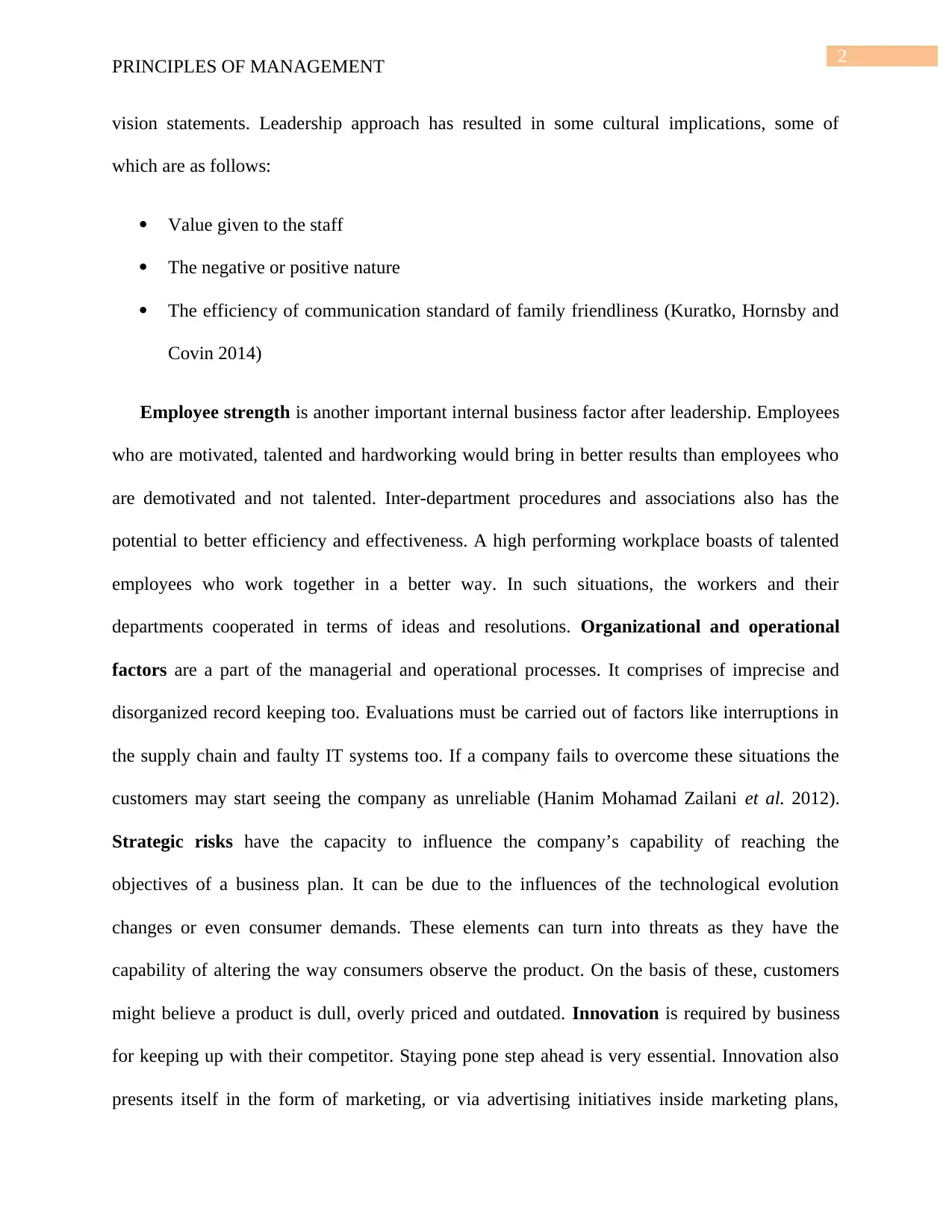
2
PRINCIPLES OF MANAGEMENT
vision statements. Leadership approach has resulted in some cultural implications, some of
which are as follows:
Value given to the staff
The negative or positive nature
The efficiency of communication standard of family friendliness (Kuratko, Hornsby and
Covin 2014)
Employee strength is another important internal business factor after leadership. Employees
who are motivated, talented and hardworking would bring in better results than employees who
are demotivated and not talented. Inter-department procedures and associations also has the
potential to better efficiency and effectiveness. A high performing workplace boasts of talented
employees who work together in a better way. In such situations, the workers and their
departments cooperated in terms of ideas and resolutions. Organizational and operational
factors are a part of the managerial and operational processes. It comprises of imprecise and
disorganized record keeping too. Evaluations must be carried out of factors like interruptions in
the supply chain and faulty IT systems too. If a company fails to overcome these situations the
customers may start seeing the company as unreliable (Hanim Mohamad Zailani et al. 2012).
Strategic risks have the capacity to influence the company’s capability of reaching the
objectives of a business plan. It can be due to the influences of the technological evolution
changes or even consumer demands. These elements can turn into threats as they have the
capability of altering the way consumers observe the product. On the basis of these, customers
might believe a product is dull, overly priced and outdated. Innovation is required by business
for keeping up with their competitor. Staying pone step ahead is very essential. Innovation also
presents itself in the form of marketing, or via advertising initiatives inside marketing plans,
PRINCIPLES OF MANAGEMENT
vision statements. Leadership approach has resulted in some cultural implications, some of
which are as follows:
Value given to the staff
The negative or positive nature
The efficiency of communication standard of family friendliness (Kuratko, Hornsby and
Covin 2014)
Employee strength is another important internal business factor after leadership. Employees
who are motivated, talented and hardworking would bring in better results than employees who
are demotivated and not talented. Inter-department procedures and associations also has the
potential to better efficiency and effectiveness. A high performing workplace boasts of talented
employees who work together in a better way. In such situations, the workers and their
departments cooperated in terms of ideas and resolutions. Organizational and operational
factors are a part of the managerial and operational processes. It comprises of imprecise and
disorganized record keeping too. Evaluations must be carried out of factors like interruptions in
the supply chain and faulty IT systems too. If a company fails to overcome these situations the
customers may start seeing the company as unreliable (Hanim Mohamad Zailani et al. 2012).
Strategic risks have the capacity to influence the company’s capability of reaching the
objectives of a business plan. It can be due to the influences of the technological evolution
changes or even consumer demands. These elements can turn into threats as they have the
capability of altering the way consumers observe the product. On the basis of these, customers
might believe a product is dull, overly priced and outdated. Innovation is required by business
for keeping up with their competitor. Staying pone step ahead is very essential. Innovation also
presents itself in the form of marketing, or via advertising initiatives inside marketing plans,
⊘ This is a preview!⊘
Do you want full access?
Subscribe today to unlock all pages.

Trusted by 1+ million students worldwide
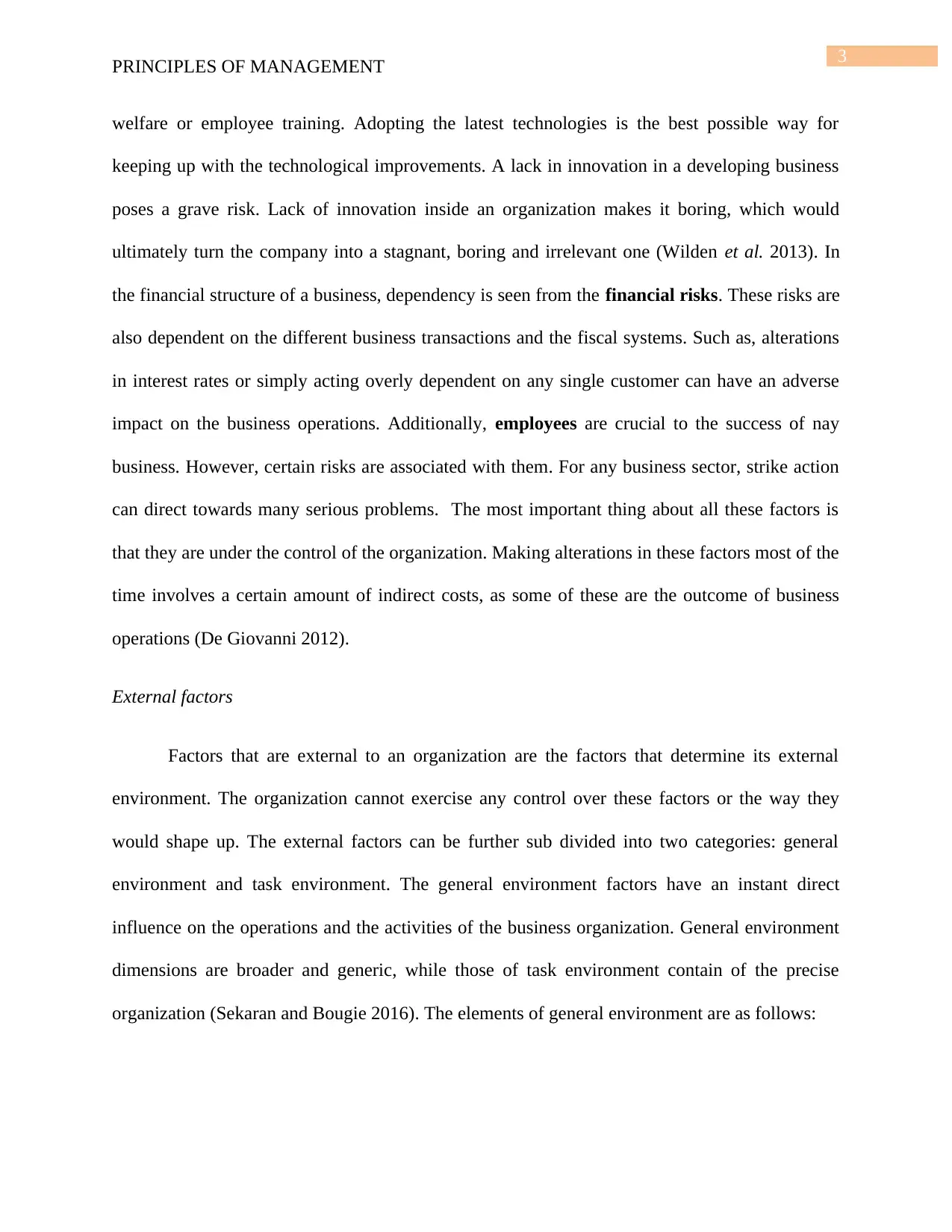
3
PRINCIPLES OF MANAGEMENT
welfare or employee training. Adopting the latest technologies is the best possible way for
keeping up with the technological improvements. A lack in innovation in a developing business
poses a grave risk. Lack of innovation inside an organization makes it boring, which would
ultimately turn the company into a stagnant, boring and irrelevant one (Wilden et al. 2013). In
the financial structure of a business, dependency is seen from the financial risks. These risks are
also dependent on the different business transactions and the fiscal systems. Such as, alterations
in interest rates or simply acting overly dependent on any single customer can have an adverse
impact on the business operations. Additionally, employees are crucial to the success of nay
business. However, certain risks are associated with them. For any business sector, strike action
can direct towards many serious problems. The most important thing about all these factors is
that they are under the control of the organization. Making alterations in these factors most of the
time involves a certain amount of indirect costs, as some of these are the outcome of business
operations (De Giovanni 2012).
External factors
Factors that are external to an organization are the factors that determine its external
environment. The organization cannot exercise any control over these factors or the way they
would shape up. The external factors can be further sub divided into two categories: general
environment and task environment. The general environment factors have an instant direct
influence on the operations and the activities of the business organization. General environment
dimensions are broader and generic, while those of task environment contain of the precise
organization (Sekaran and Bougie 2016). The elements of general environment are as follows:
PRINCIPLES OF MANAGEMENT
welfare or employee training. Adopting the latest technologies is the best possible way for
keeping up with the technological improvements. A lack in innovation in a developing business
poses a grave risk. Lack of innovation inside an organization makes it boring, which would
ultimately turn the company into a stagnant, boring and irrelevant one (Wilden et al. 2013). In
the financial structure of a business, dependency is seen from the financial risks. These risks are
also dependent on the different business transactions and the fiscal systems. Such as, alterations
in interest rates or simply acting overly dependent on any single customer can have an adverse
impact on the business operations. Additionally, employees are crucial to the success of nay
business. However, certain risks are associated with them. For any business sector, strike action
can direct towards many serious problems. The most important thing about all these factors is
that they are under the control of the organization. Making alterations in these factors most of the
time involves a certain amount of indirect costs, as some of these are the outcome of business
operations (De Giovanni 2012).
External factors
Factors that are external to an organization are the factors that determine its external
environment. The organization cannot exercise any control over these factors or the way they
would shape up. The external factors can be further sub divided into two categories: general
environment and task environment. The general environment factors have an instant direct
influence on the operations and the activities of the business organization. General environment
dimensions are broader and generic, while those of task environment contain of the precise
organization (Sekaran and Bougie 2016). The elements of general environment are as follows:
Paraphrase This Document
Need a fresh take? Get an instant paraphrase of this document with our AI Paraphraser
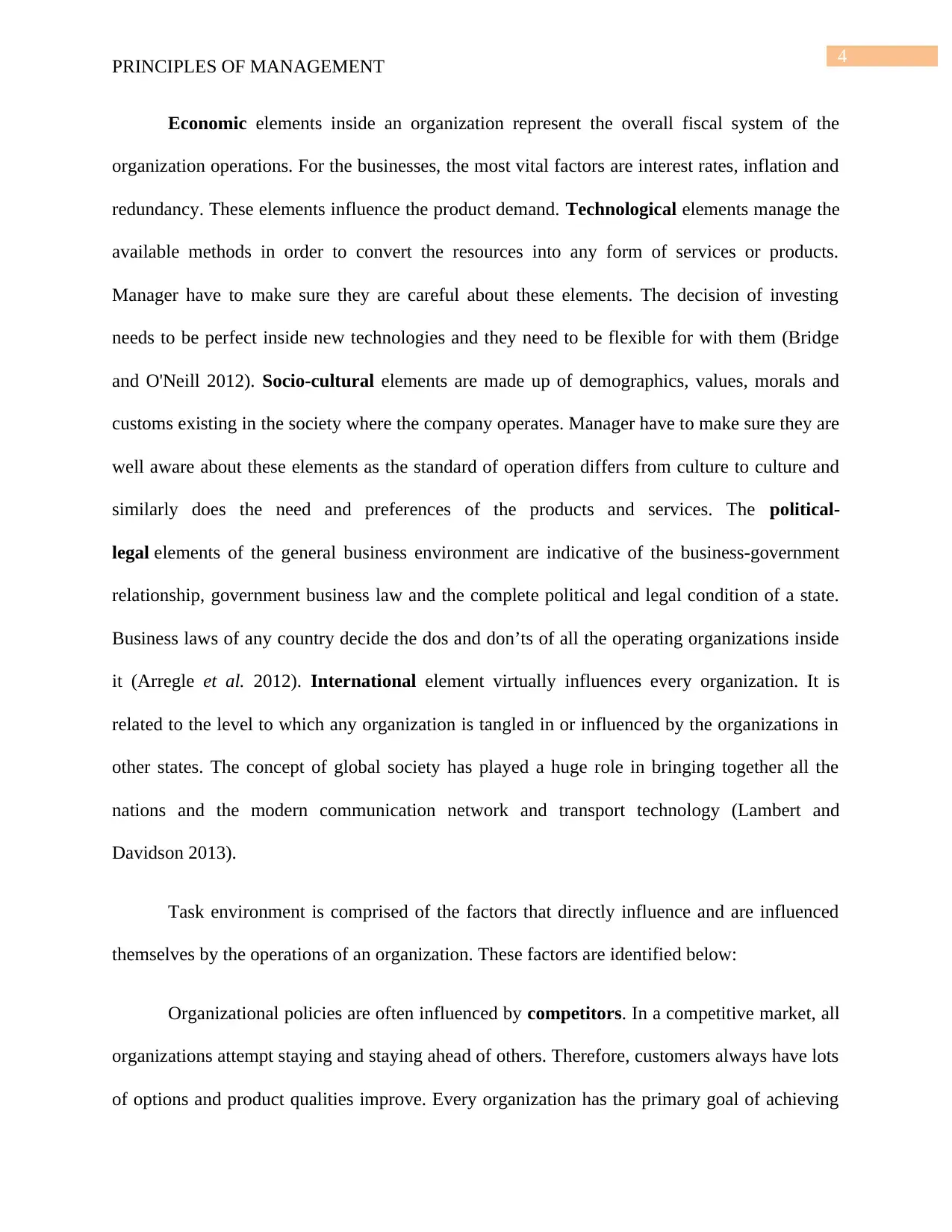
4
PRINCIPLES OF MANAGEMENT
Economic elements inside an organization represent the overall fiscal system of the
organization operations. For the businesses, the most vital factors are interest rates, inflation and
redundancy. These elements influence the product demand. Technological elements manage the
available methods in order to convert the resources into any form of services or products.
Manager have to make sure they are careful about these elements. The decision of investing
needs to be perfect inside new technologies and they need to be flexible for with them (Bridge
and O'Neill 2012). Socio-cultural elements are made up of demographics, values, morals and
customs existing in the society where the company operates. Manager have to make sure they are
well aware about these elements as the standard of operation differs from culture to culture and
similarly does the need and preferences of the products and services. The political-
legal elements of the general business environment are indicative of the business-government
relationship, government business law and the complete political and legal condition of a state.
Business laws of any country decide the dos and don’ts of all the operating organizations inside
it (Arregle et al. 2012). International element virtually influences every organization. It is
related to the level to which any organization is tangled in or influenced by the organizations in
other states. The concept of global society has played a huge role in bringing together all the
nations and the modern communication network and transport technology (Lambert and
Davidson 2013).
Task environment is comprised of the factors that directly influence and are influenced
themselves by the operations of an organization. These factors are identified below:
Organizational policies are often influenced by competitors. In a competitive market, all
organizations attempt staying and staying ahead of others. Therefore, customers always have lots
of options and product qualities improve. Every organization has the primary goal of achieving
PRINCIPLES OF MANAGEMENT
Economic elements inside an organization represent the overall fiscal system of the
organization operations. For the businesses, the most vital factors are interest rates, inflation and
redundancy. These elements influence the product demand. Technological elements manage the
available methods in order to convert the resources into any form of services or products.
Manager have to make sure they are careful about these elements. The decision of investing
needs to be perfect inside new technologies and they need to be flexible for with them (Bridge
and O'Neill 2012). Socio-cultural elements are made up of demographics, values, morals and
customs existing in the society where the company operates. Manager have to make sure they are
well aware about these elements as the standard of operation differs from culture to culture and
similarly does the need and preferences of the products and services. The political-
legal elements of the general business environment are indicative of the business-government
relationship, government business law and the complete political and legal condition of a state.
Business laws of any country decide the dos and don’ts of all the operating organizations inside
it (Arregle et al. 2012). International element virtually influences every organization. It is
related to the level to which any organization is tangled in or influenced by the organizations in
other states. The concept of global society has played a huge role in bringing together all the
nations and the modern communication network and transport technology (Lambert and
Davidson 2013).
Task environment is comprised of the factors that directly influence and are influenced
themselves by the operations of an organization. These factors are identified below:
Organizational policies are often influenced by competitors. In a competitive market, all
organizations attempt staying and staying ahead of others. Therefore, customers always have lots
of options and product qualities improve. Every organization has the primary goal of achieving
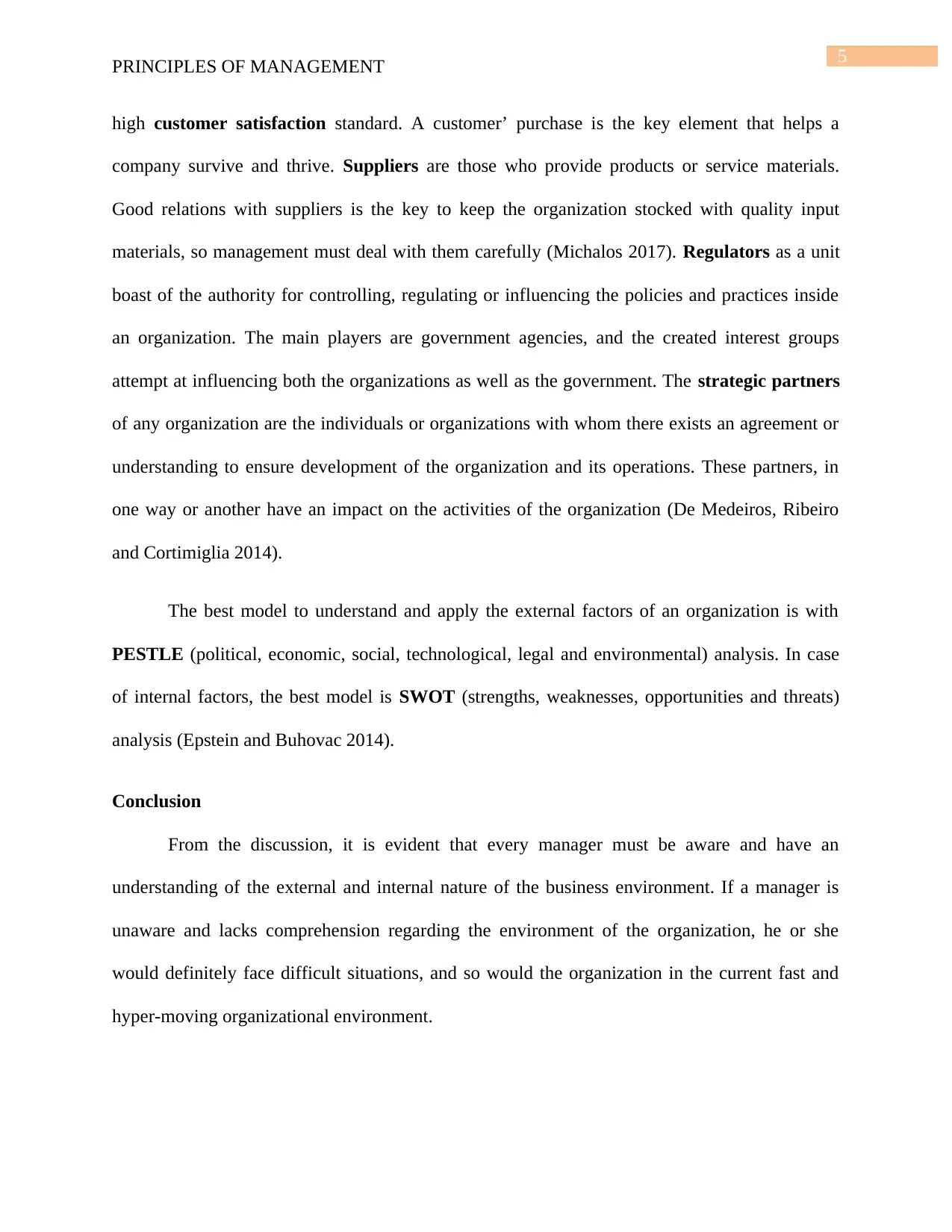
5
PRINCIPLES OF MANAGEMENT
high customer satisfaction standard. A customer’ purchase is the key element that helps a
company survive and thrive. Suppliers are those who provide products or service materials.
Good relations with suppliers is the key to keep the organization stocked with quality input
materials, so management must deal with them carefully (Michalos 2017). Regulators as a unit
boast of the authority for controlling, regulating or influencing the policies and practices inside
an organization. The main players are government agencies, and the created interest groups
attempt at influencing both the organizations as well as the government. The strategic partners
of any organization are the individuals or organizations with whom there exists an agreement or
understanding to ensure development of the organization and its operations. These partners, in
one way or another have an impact on the activities of the organization (De Medeiros, Ribeiro
and Cortimiglia 2014).
The best model to understand and apply the external factors of an organization is with
PESTLE (political, economic, social, technological, legal and environmental) analysis. In case
of internal factors, the best model is SWOT (strengths, weaknesses, opportunities and threats)
analysis (Epstein and Buhovac 2014).
Conclusion
From the discussion, it is evident that every manager must be aware and have an
understanding of the external and internal nature of the business environment. If a manager is
unaware and lacks comprehension regarding the environment of the organization, he or she
would definitely face difficult situations, and so would the organization in the current fast and
hyper-moving organizational environment.
PRINCIPLES OF MANAGEMENT
high customer satisfaction standard. A customer’ purchase is the key element that helps a
company survive and thrive. Suppliers are those who provide products or service materials.
Good relations with suppliers is the key to keep the organization stocked with quality input
materials, so management must deal with them carefully (Michalos 2017). Regulators as a unit
boast of the authority for controlling, regulating or influencing the policies and practices inside
an organization. The main players are government agencies, and the created interest groups
attempt at influencing both the organizations as well as the government. The strategic partners
of any organization are the individuals or organizations with whom there exists an agreement or
understanding to ensure development of the organization and its operations. These partners, in
one way or another have an impact on the activities of the organization (De Medeiros, Ribeiro
and Cortimiglia 2014).
The best model to understand and apply the external factors of an organization is with
PESTLE (political, economic, social, technological, legal and environmental) analysis. In case
of internal factors, the best model is SWOT (strengths, weaknesses, opportunities and threats)
analysis (Epstein and Buhovac 2014).
Conclusion
From the discussion, it is evident that every manager must be aware and have an
understanding of the external and internal nature of the business environment. If a manager is
unaware and lacks comprehension regarding the environment of the organization, he or she
would definitely face difficult situations, and so would the organization in the current fast and
hyper-moving organizational environment.
⊘ This is a preview!⊘
Do you want full access?
Subscribe today to unlock all pages.

Trusted by 1+ million students worldwide
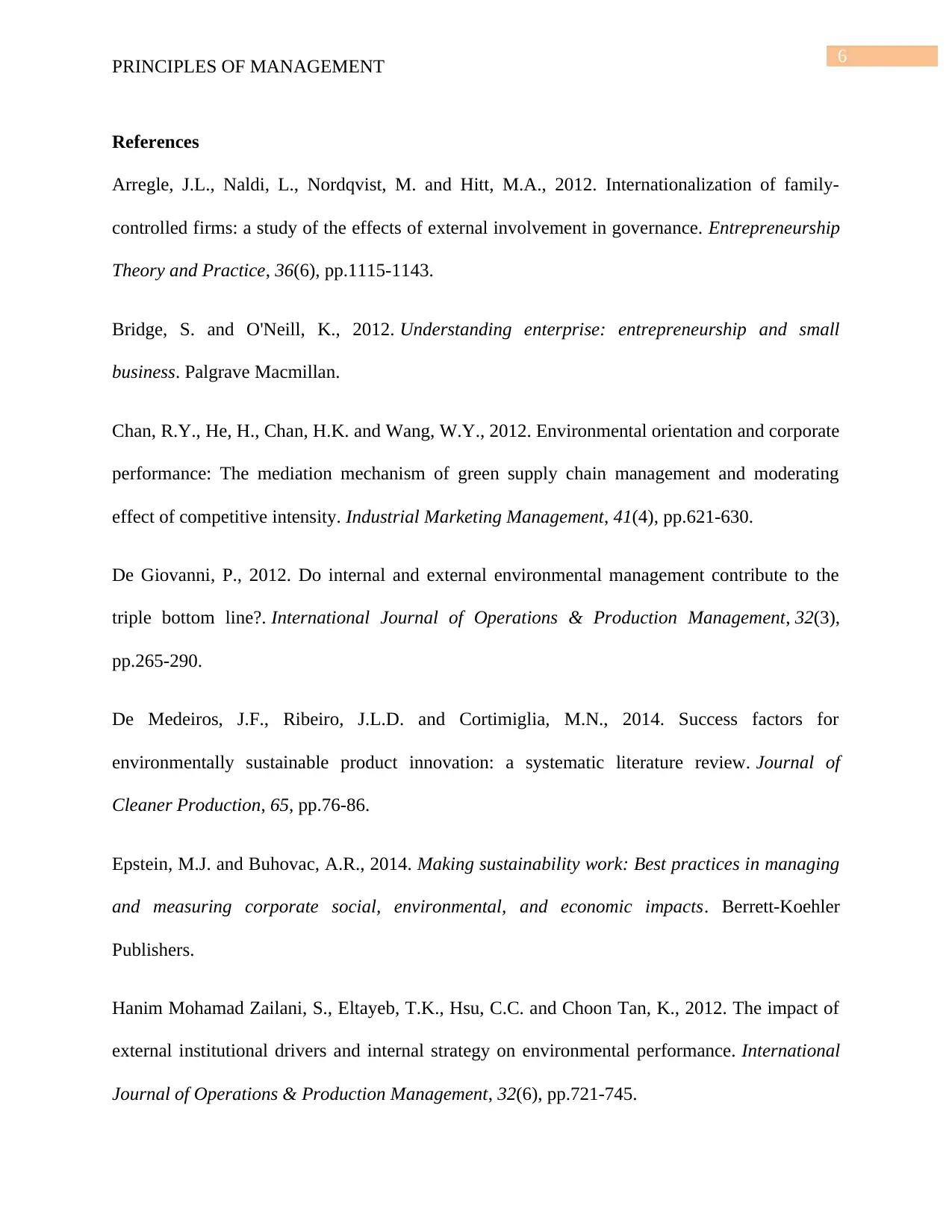
6
PRINCIPLES OF MANAGEMENT
References
Arregle, J.L., Naldi, L., Nordqvist, M. and Hitt, M.A., 2012. Internationalization of family‐
controlled firms: a study of the effects of external involvement in governance. Entrepreneurship
Theory and Practice, 36(6), pp.1115-1143.
Bridge, S. and O'Neill, K., 2012. Understanding enterprise: entrepreneurship and small
business. Palgrave Macmillan.
Chan, R.Y., He, H., Chan, H.K. and Wang, W.Y., 2012. Environmental orientation and corporate
performance: The mediation mechanism of green supply chain management and moderating
effect of competitive intensity. Industrial Marketing Management, 41(4), pp.621-630.
De Giovanni, P., 2012. Do internal and external environmental management contribute to the
triple bottom line?. International Journal of Operations & Production Management, 32(3),
pp.265-290.
De Medeiros, J.F., Ribeiro, J.L.D. and Cortimiglia, M.N., 2014. Success factors for
environmentally sustainable product innovation: a systematic literature review. Journal of
Cleaner Production, 65, pp.76-86.
Epstein, M.J. and Buhovac, A.R., 2014. Making sustainability work: Best practices in managing
and measuring corporate social, environmental, and economic impacts. Berrett-Koehler
Publishers.
Hanim Mohamad Zailani, S., Eltayeb, T.K., Hsu, C.C. and Choon Tan, K., 2012. The impact of
external institutional drivers and internal strategy on environmental performance. International
Journal of Operations & Production Management, 32(6), pp.721-745.
PRINCIPLES OF MANAGEMENT
References
Arregle, J.L., Naldi, L., Nordqvist, M. and Hitt, M.A., 2012. Internationalization of family‐
controlled firms: a study of the effects of external involvement in governance. Entrepreneurship
Theory and Practice, 36(6), pp.1115-1143.
Bridge, S. and O'Neill, K., 2012. Understanding enterprise: entrepreneurship and small
business. Palgrave Macmillan.
Chan, R.Y., He, H., Chan, H.K. and Wang, W.Y., 2012. Environmental orientation and corporate
performance: The mediation mechanism of green supply chain management and moderating
effect of competitive intensity. Industrial Marketing Management, 41(4), pp.621-630.
De Giovanni, P., 2012. Do internal and external environmental management contribute to the
triple bottom line?. International Journal of Operations & Production Management, 32(3),
pp.265-290.
De Medeiros, J.F., Ribeiro, J.L.D. and Cortimiglia, M.N., 2014. Success factors for
environmentally sustainable product innovation: a systematic literature review. Journal of
Cleaner Production, 65, pp.76-86.
Epstein, M.J. and Buhovac, A.R., 2014. Making sustainability work: Best practices in managing
and measuring corporate social, environmental, and economic impacts. Berrett-Koehler
Publishers.
Hanim Mohamad Zailani, S., Eltayeb, T.K., Hsu, C.C. and Choon Tan, K., 2012. The impact of
external institutional drivers and internal strategy on environmental performance. International
Journal of Operations & Production Management, 32(6), pp.721-745.
Paraphrase This Document
Need a fresh take? Get an instant paraphrase of this document with our AI Paraphraser
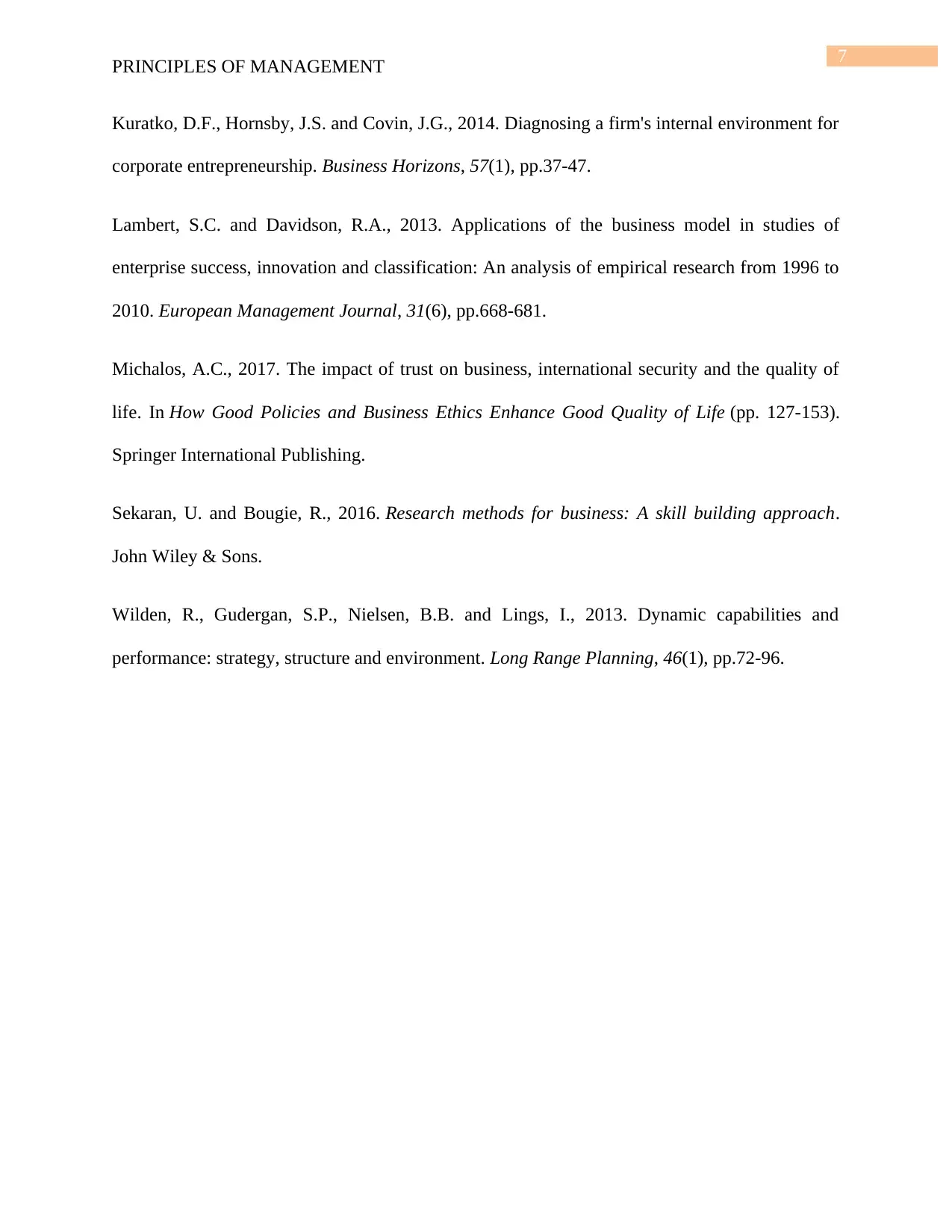
7
PRINCIPLES OF MANAGEMENT
Kuratko, D.F., Hornsby, J.S. and Covin, J.G., 2014. Diagnosing a firm's internal environment for
corporate entrepreneurship. Business Horizons, 57(1), pp.37-47.
Lambert, S.C. and Davidson, R.A., 2013. Applications of the business model in studies of
enterprise success, innovation and classification: An analysis of empirical research from 1996 to
2010. European Management Journal, 31(6), pp.668-681.
Michalos, A.C., 2017. The impact of trust on business, international security and the quality of
life. In How Good Policies and Business Ethics Enhance Good Quality of Life (pp. 127-153).
Springer International Publishing.
Sekaran, U. and Bougie, R., 2016. Research methods for business: A skill building approach.
John Wiley & Sons.
Wilden, R., Gudergan, S.P., Nielsen, B.B. and Lings, I., 2013. Dynamic capabilities and
performance: strategy, structure and environment. Long Range Planning, 46(1), pp.72-96.
PRINCIPLES OF MANAGEMENT
Kuratko, D.F., Hornsby, J.S. and Covin, J.G., 2014. Diagnosing a firm's internal environment for
corporate entrepreneurship. Business Horizons, 57(1), pp.37-47.
Lambert, S.C. and Davidson, R.A., 2013. Applications of the business model in studies of
enterprise success, innovation and classification: An analysis of empirical research from 1996 to
2010. European Management Journal, 31(6), pp.668-681.
Michalos, A.C., 2017. The impact of trust on business, international security and the quality of
life. In How Good Policies and Business Ethics Enhance Good Quality of Life (pp. 127-153).
Springer International Publishing.
Sekaran, U. and Bougie, R., 2016. Research methods for business: A skill building approach.
John Wiley & Sons.
Wilden, R., Gudergan, S.P., Nielsen, B.B. and Lings, I., 2013. Dynamic capabilities and
performance: strategy, structure and environment. Long Range Planning, 46(1), pp.72-96.
1 out of 8
Related Documents
Your All-in-One AI-Powered Toolkit for Academic Success.
+13062052269
info@desklib.com
Available 24*7 on WhatsApp / Email
![[object Object]](/_next/static/media/star-bottom.7253800d.svg)
Unlock your academic potential
Copyright © 2020–2025 A2Z Services. All Rights Reserved. Developed and managed by ZUCOL.




